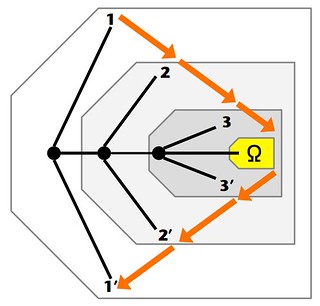This is just a quick and dirty note, as a reminder and for the record. The orange arrows in the figure below indicate Marlow’s narrative/journey in Heart of Darkness. The nested boxes – think Matryoshka dolls, but also the structure of “Kubla Khan” – are the “myth logic” that projects the interior psyche onto the external world. We’re moving from civilized reason (Europe) through (primitive) Africa to basic human bonding (Ω).
Yeah, I know. It needs work. But not now. It’s a starting point.
1. Women hook Marlow up with a pilot’s job.2. Marlow leaves Europe for the Congo.3. Travels upriver into Africa.Ω The NEXUS: Marlow bonds with helmsman.3’. Marlow retrieves the ivory and Kurtz.2’. Kurtz dies on journey back.1’. Marlow lies to the Intended about Kurtz’s last words
The journey to and from the Central Journey becomes, in retrospective telling, an interior journey. That is, I’m asserting that it is really only in retrospect that Marlow realizes the importance of his bonding with the (incompetent) helmsman of his boat. That realization comes in his telling the story to those London gentlemen on that yacht in the Thames, which is at the very end of the Nexus paragraph, after he laid out that account of Kurtz that pretty much identified him with Europe.
And that’s why he so vigorously rejects women at the beginning of the Nexus. The English novel, but not the American, has used the attachment of man and woman in marriage/betrothal as central framing device. Heart of Darkness rejects that. It has no choice, as it's exploring quite a different psycho-cultural dynamic, one that's more abstractly linked to identity and state (a nation-state in Europe). These more abstract issues are also central to Apocalypse Now, the movie loosely based on Heart of Darkness.
More later.

No comments:
Post a Comment